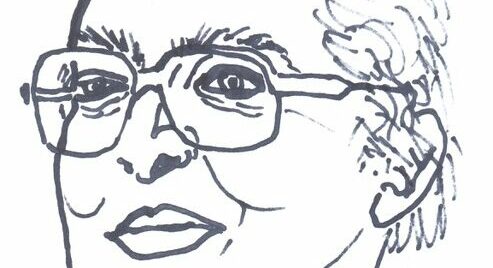Literatur/Performance
ONLINE: A TRIBUTE TO FRIEDRICH DĂśRRENMATT

Irmi Horn is reading about  and from Friedrich Dürrenmatt ➨ DIE PANNE.
The editor and lecturer in linguistics Matthias Leimbach draws the following conclusion:
With Die Panne DĂĽrrenmatt has succeeded in writing one of the most important German narratives of the 20th century, whose special finesse comes from the combination of content and form.In terms of content, the courtroom play of the ancients is in the foreground. This is joined by the play with identity designs, which the lawyers engage in as a kind of mise en abyme and thus metatextually refer to DĂĽrrenmatt’s concept of possible narratives. It is an experimental narrative in which the author tests possibilities of narration by having his own characters try them out.DĂĽrrenmatt exposes the power of narration by using the example of Alfredo Traps to drill through it. This seems so significant because not only does he give his characters different designs, but because he himself has written three different endings. These alternatives have an important meaning for DĂĽrrenmatt’s question of guilt, because they show that there are no longer any clear answers in the modern world. The evaluation of guilt has lost its objective criteria.To put this in concrete terms: Objectivity is no longer possible because it is always dependent on a representation, a narrative. DĂĽrrenmatt shows that there are always different versions of a truth. Thus, the narrative in itself is insignificant, since it is interchangeable. It gains its real power only through the way it is told. Because different narratives are also interpreted differently. To make a narrative most convincing is to lay claim to the one true story – truth, and Trap’s case the guilt, is non-existent until it is credibly told. This is impressively demonstrated in The Breakdown in a complex narrative structure.
Friedrich Dürrenmatt est né le 5 janvier 1921 à Konolfingen près de Berne, fils d’un prêtre. Il a étudié la philosophie à Berne et à Zurich et a vécu à Neuchâtel en tant que dramaturge, conteur, essayiste, dessinateur et peintre. Il est devenu célèbre pour ses romans policiers et ses histoires “Le juge et son bourreau”, “Soupçon”, “La panne” et “La promesse”, et mondialement connu pour les comédies “La visite de la vieille dame” et “Les physiciens”. C’est la conclusion de son vaste travail avec les “Stoffen”, dans lequel il a combiné l’autobiographie et l’essai. Friedrich Dürrenmatt est mort le 14 décembre 1990 à Neuchâtel.Aucun autre écrivain suisse n’a inspiré plus de cinéastes que Friedrich Dürrenmatt, qui aurait eu 100 ans en janvier. Son matériel a été adapté dans le monde entier parce qu’il tournait autour de thèmes universels tels que la justice, la foi et la vengeance, mais laissait une grande marge de manœuvre pour des adaptations idiosyncrasiques. Dürrenmatt a été filmé partout dans le monde à tout moment : à Hollywood, en Asie, en Italie, en Hongrie et même au Sénégal (Hyènes de Djibril Diop Mambéty).Friedrich Dürrenmatt (1921-1990) lui-même, qui a été marié deux fois à une actrice, aimait le cinéma. Son parcours scolaire à Berne l’a mené devant huit cinémas et il passait souvent des après-midi entières sous le charme de l’écran alors que ses parents le croyaient à l’école. Le support visuel a également aidé le rejeton d’un prêtre de campagne à s’émanciper de son foyer parental protestant.

